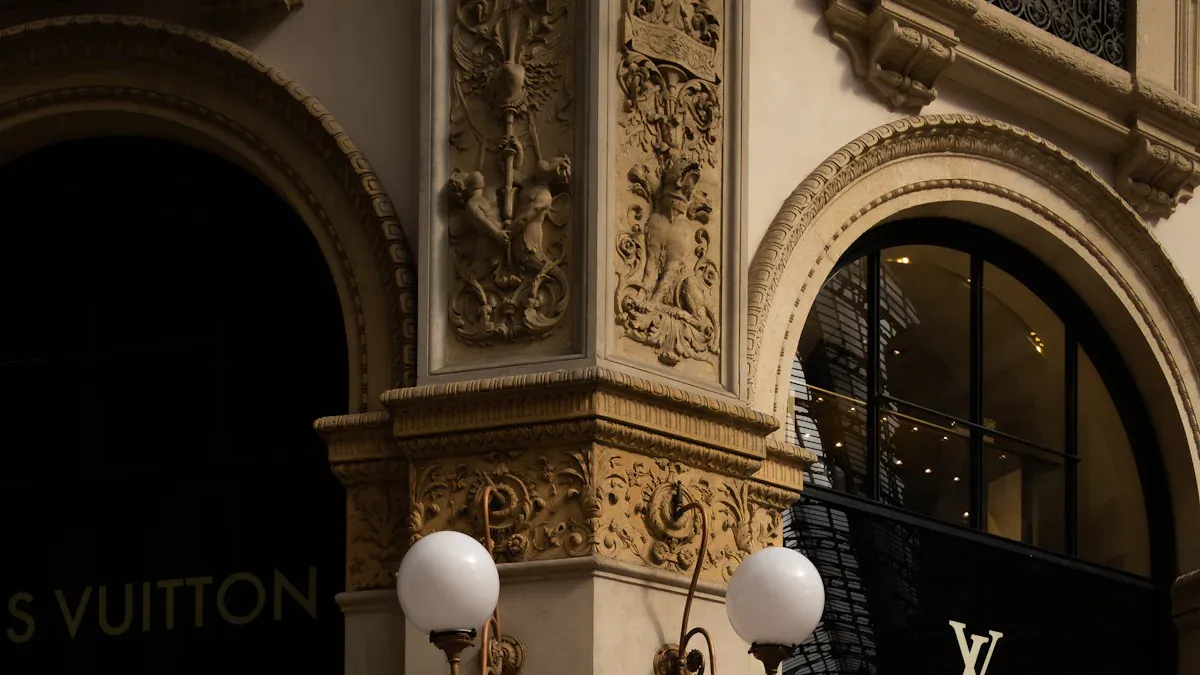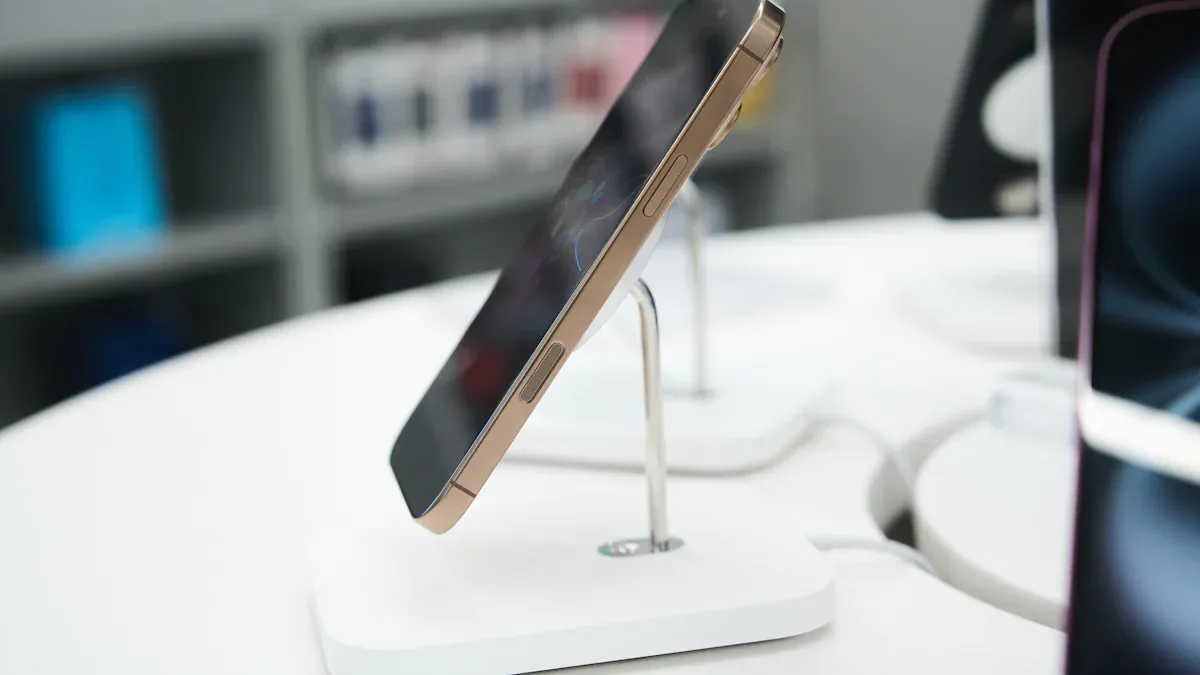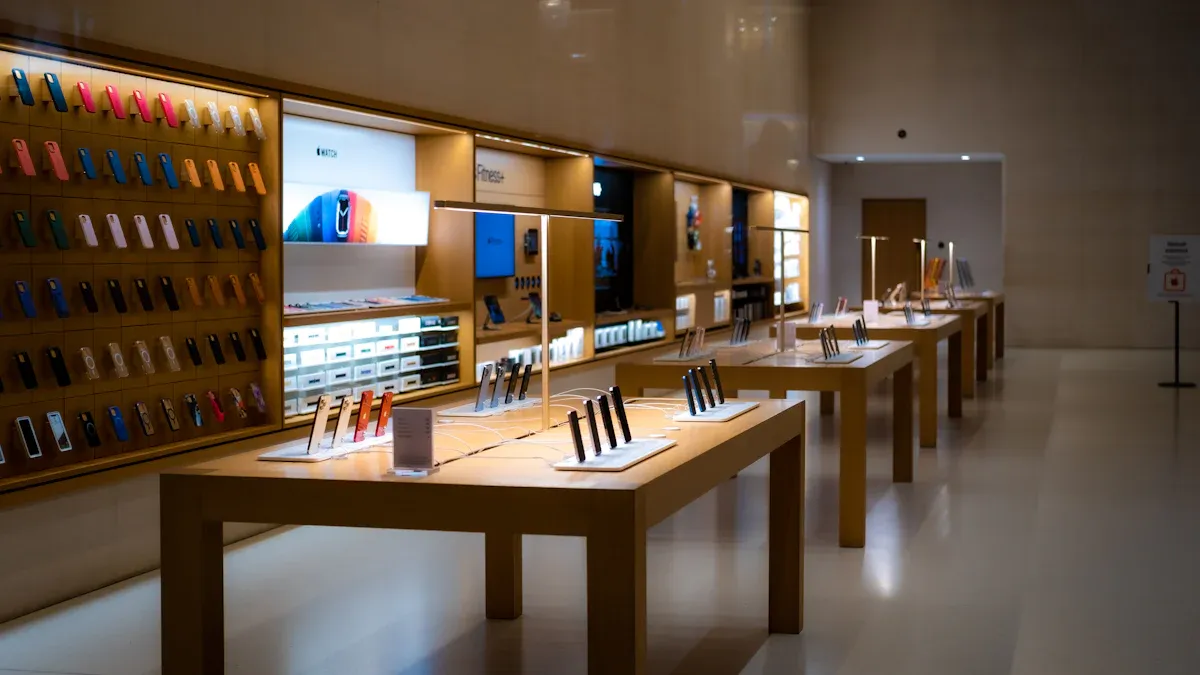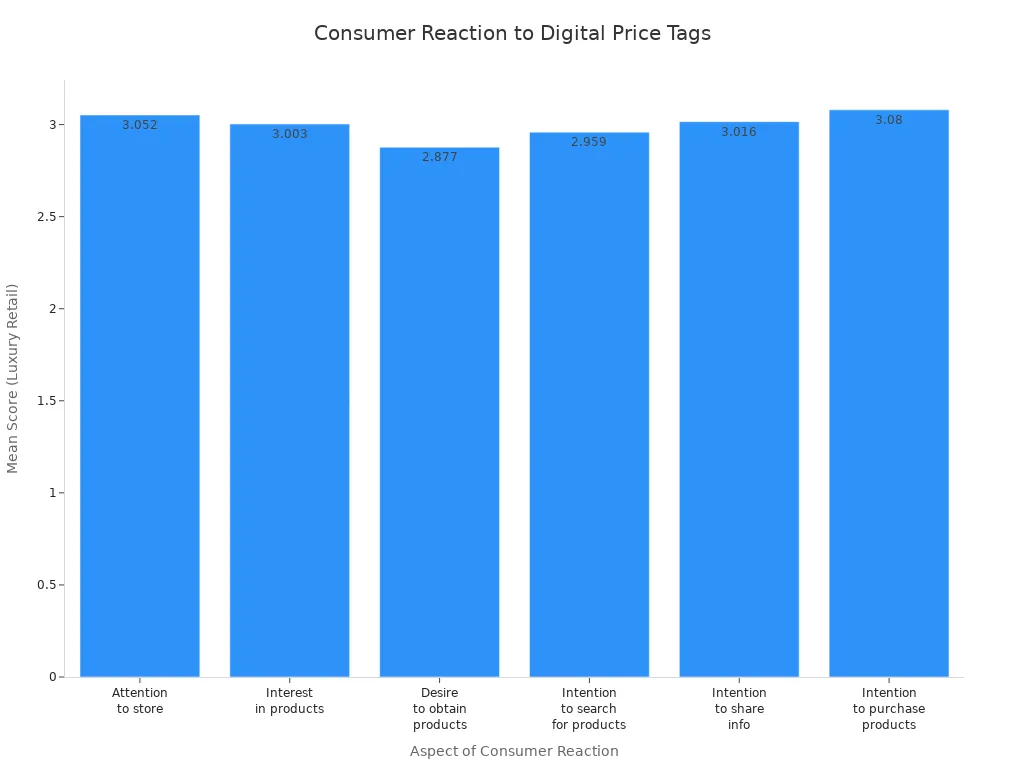
Louis Vuitton maintains traditional price tags in every boutique. Shoppers will not encounter digital price tags, Electronic Shelf Labels, or ESL Price Tag systems within any Louis Vuitton location. The ESL Gateway AP and Esl Retail solutions, common in other sectors, do not feature in Vuitton’s pricing approach. Louis ensures customers experience no additional expense linked to these technologies.
Digital price tags in luxury retail

What are digital price tags?
Definition and technology
Digital price tags represent a modern solution for displaying product information in retail environments. These electronic labels replace traditional paper tags with advanced displays that can show prices, product details, and promotional messages. Retailers often choose from several types of digital price tags to match their store’s aesthetic and operational needs.
- E-Paper Electronic Shelf Labels (ESLs) offer a paper-like appearance, high readability, and low power consumption. Their minimalistic design fits well in luxury settings.
- LCD ESLs provide vibrant visuals and support dynamic content, including images and QR codes. These labels suit stores that frequently update product information.
- LED ESLs stand out with bright, attention-grabbing displays, making them ideal for highlighting featured or promotional items.
| Label Type | Technology & Features | Use in Luxury Retail |
|---|---|---|
| E-Paper ESLs | Low power, high readability, long lifespan, paper-like | Preferred for elegance and longevity |
| LCD ESLs | Full-color, dynamic content, supports images and QR codes | Used for frequent price changes and rich product info |
| LED Labels | Bright, attention-grabbing, limited text capacity | Ideal for highlighting sales or featured items |
| RFID Labels | Radio-frequency identification for inventory tracking | Used for managing high-value inventory |
How digital price tags work
Digital price tags connect wirelessly to a central system. Store managers can update prices and product information instantly across all displays. This system eliminates the need for manual label changes and ensures accuracy. The technology supports real-time updates, which helps luxury retailers maintain consistency and efficiency.
Why luxury brands consider digital price tags
Benefits for luxury retailers
Luxury retailers seek to enhance both operational efficiency and customer experience. Digital price tags automate price and stock updates, reducing manual errors and saving staff time. These tags provide real-time, detailed product information, such as care instructions and authenticity features, which supports the high expectations of luxury shoppers. They also ensure consistent pricing across all locations, building trust with customers.
- Digital price tags allow for instant updates on promotions and offers.
- They enable easy in-store price comparison, empowering customers.
- Integration with other in-store technologies creates a connected shopping environment.
- Centralized updates streamline operations and support a modern retail experience.
Industry trends and adoption
Many luxury brands now explore digital price tags to modernize their stores. Adoption of this technology sets new industry standards and encourages competitors to follow. As high-end fashion retailers look for ways to meet evolving customer expectations, digital price tags help bridge the gap between tradition and innovation.
Digital price tags vs. traditional price tags
Real-time updates and accuracy
Traditional price tags require staff to print and replace labels manually. This process takes time and can lead to errors. Digital price tags allow for simultaneous, real-time updates across all stores. Retailers benefit from reduced labor hours, fewer pricing mistakes, and the ability to implement dynamic pricing strategies, such as flash sales or localized offers.
Security and brand image
Digital price tags support secure, centralized control over pricing information. This reduces the risk of tampering and maintains the integrity of the luxury brand. The sleek design of electronic labels also enhances store aesthetics, aligning with the premium image expected in luxury retail.
Louis Vuitton and price tags: Current practices
Traditional price tags at Louis Vuitton
Materials and design
Louis Vuitton uses traditional price tags crafted from premium materials that reflect the brand’s commitment to quality. These tags often feature thick, high-grade paper or card stock, sometimes with subtle embossing or gold accents. The design remains understated, aligning with the brand’s minimalist aesthetic. The tags display essential product information, such as model name and reference number, but rarely include excessive details. This approach ensures that the focus stays on the product itself, reinforcing the luxury experience.
Placement and visibility in stores
Store associates at Louis Vuitton boutiques place price tags discreetly. They often tuck tags inside bags or attach them in a way that does not detract from the product’s presentation. This subtle placement supports the brand’s emphasis on exclusivity and personal service. Associates typically reveal prices only upon request, allowing for a more personalized interaction. The strategy maintains an air of discretion, which many luxury shoppers expect.
RFID and technology in Louis Vuitton products
RFID microchips and date codes
Louis Vuitton has evolved its product identification methods over the past decade. The brand initially relied on date codes stamped inside products to indicate manufacturing details. In March 2021, Louis Vuitton transitioned to embedding RFID microchips in leather goods and small accessories. These RFID tags store product information securely, often on a private blockchain, which enhances authenticity verification and traceability. During the transition, some items from 2019 and 2020 included both date codes and RFID tags. The integration of Near-Field Communication (NFC) tags allows consumers to verify authenticity using mobile devices. Louis Vuitton also joined the Aura Blockchain Consortium, collaborating with other luxury brands to leverage blockchain for product history tracking and anti-counterfeiting.
Note: While RFID and NFC technologies improve security, they are not foolproof. Criminals have exploited vulnerabilities by removing or duplicating tags, prompting Louis Vuitton to implement additional security measures such as secure codes that resist replication.
Inventory management and authenticity
RFID technology plays a critical role in Louis Vuitton’s inventory management and product authentication. The brand embeds RFID tags in products like handbags, enabling real-time inventory tracking. This system reduces discrepancies, prevents theft, and ensures that high-demand items remain available. RFID data also supports personalized marketing by tracking customer preferences and purchase history, which fosters brand loyalty. The technology enhances supply chain transparency and improves the customer experience, especially as online luxury sales increase. Despite some vulnerabilities, RFID remains a vital tool for Louis Vuitton’s operations.
Brand strategy and price tag policies
Consistency across global stores
Louis Vuitton enforces a strict premium pricing policy worldwide. The brand maintains consistent prices across markets, with only minor adjustments for currency, taxes, or duties. Louis Vuitton does not allow discounts or sales, preserving exclusivity and brand value. Products are sold primarily through company-owned stores and licensed distributors, which allows the brand to control the shopping experience and ensure product authenticity. While there is no explicit official policy regarding the display of price tags in stores, the focus remains on price consistency and brand integrity rather than physical tag presentation.
Impact on customer experience
Louis Vuitton’s approach to price tags and pricing policies shapes the customer experience in several ways:
- Customers encounter a consistent pricing structure, which reinforces trust and transparency.
- The absence of discounts or sales maintains the perception of exclusivity.
- Direct control over production and distribution enables Louis Vuitton to deliver a cohesive brand experience, unlike competitors who rely on third-party retailers.
- Discreet price tag placement and personalized service create an intimate shopping environment, aligning with luxury expectations.
This strategy supports Louis Vuitton’s reputation as a leader in the luxury market and strengthens the connection between the brand and its clientele.
Cost analysis of digital price tags for Louis Vuitton
Potential investment for the brand
Technology and installation costs
Luxury retailers face significant upfront expenses when adopting digital price tags. The process involves purchasing electronic shelf labels, installing gateways, and integrating cloud-based management platforms. These systems require careful financial planning, as the initial investment often exceeds that of traditional price tag systems. For example, Kroger’s implementation of digital price tags, known as ‘Kroger Edge,’ highlights operational advantages such as instant updates and energy savings. However, the transition demands a substantial budget for technology, setup, and employee training. Retailers must weigh these costs against the potential for improved efficiency and sustainability.
Maintenance and upgrades
Ongoing maintenance forms a crucial part of the investment. Digital price tag systems need regular software updates, hardware replacements, and technical support. Brands must allocate resources for troubleshooting and system upgrades to ensure smooth operation. While these recurring expenses add to the total cost, they also help maintain system reliability and security. Over time, the automation of price updates and reduced manual labor can offset some of these expenditures, but the initial financial outlay remains a key consideration for luxury brands like Louis Vuitton.
Cost to the customer
No direct charges for digital price tags
Customers at Louis Vuitton do not pay extra for digital price tags, as the brand currently uses traditional tags. Even if the brand adopts digital price tags in the future, the cost would likely remain an internal operational expense. Shoppers would not see a separate fee or surcharge related to this technology on their receipts.
Price transparency and luxury pricing
Price transparency plays a vital role in building trust within luxury retail. Research shows that clear and accessible pricing information reduces consumer uncertainty and enhances confidence, especially in high-value purchases. Transparent pricing also shapes customer perceptions of fairness and value, which strengthens loyalty. In luxury environments, brands that communicate price increases openly and avoid hidden fees foster a sense of integrity and reliability. This approach differentiates them in a competitive market and encourages repeat business.
Tip: Brands that clearly communicate their pricing structures and avoid hidden costs build stronger reputations and deeper customer relationships.
Value proposition for Louis Vuitton
Operational efficiency
Digital price tags offer operational benefits by automating price updates and minimizing manual errors. Employees can focus on higher-value tasks, such as personalized service, rather than spending time changing labels. Centralized pricing management ensures consistency across all locations, which is essential for a global luxury brand. The system also supports quick responses to market changes, including price increases, without disrupting the in-store experience.
Long-term brand benefits
Luxury retailers that implement digital price tags experience several long-term advantages:
| Long-term Brand Benefit | Explanation |
|---|---|
| Enhanced Shopper Experience | Real-time price updates and engaging displays improve customer interaction. |
| Operational Efficiency | Automation reduces manual labor and optimizes store operations. |
| Regulatory Compliance | Instant updates help meet changing regulations, especially in sectors like cosmetics. |
| Data-Driven Insights | Integration with analytics platforms enables better pricing and inventory strategies. |
| Brand Future-Proofing | Compatibility with evolving retail technology ensures long-term relevance. |
| Premium Brand Positioning | High-quality displays reinforce exclusivity and premium image. |
These benefits support Louis Vuitton’s reputation for innovation and excellence. By investing in digital price tags, the brand can enhance operational efficiency and maintain its leadership in the luxury market, even as price increases and customer expectations evolve.
Impact of digital price tags on the luxury experience

Enhancing the in-store experience
Seamless aesthetics and modernity
Luxury boutiques strive for a refined and modern atmosphere. Custom electronic price tag stands blend into retail spaces, offering sophistication through customizable colors and finishes. These stands help maintain clean visual merchandising by presenting pricing information in a neat, modern way. Digital price tags with HD graphic displays allow each item to feature individualized, visually appealing labels. This technology reduces clutter from paper tags and enables quick, remote updates, which streamlines the store environment. Interactive features, such as NFC and QR codes, further elevate the shopping experience. The result is a seamless, contemporary aesthetic that aligns with the expectations of luxury goods shoppers.
Personalized service opportunities
Digital price tags free staff from repetitive tasks, allowing them to focus on delivering personalized service. Associates can spend more time engaging with clients, sharing product stories, and offering tailored recommendations. The integration of interactive technologies, such as real-time data synchronization, supports a more connected and responsive service model. This shift enhances the sense of exclusivity and attention that defines luxury retail.
Supporting staff and operations
Reducing manual updates
Digital price tags automate price changes across all locations, eliminating the need for manual updates. Staff no longer face delays or errors from outdated tags. Automation ensures 100% price accuracy and prevents mismatches at checkout. Employees can dedicate more time to customer engagement and sales, which improves operational efficiency.
- Enable instant, chain-wide price updates
- Allow seamless activation of promotions
- Prevent pricing errors and losses
- Reduce extra labor, freeing staff for client service
Improving inventory accuracy
RFID technology, often paired with digital price tags, provides real-time product tracking. This capability reduces stockouts and overstocks, supporting precise inventory management for luxury goods. Electronic shelf monitors integrate with stock systems to automate updates and alert managers when products run low. The result is fewer manual errors and improved operational flexibility. Staff can focus on high-value tasks, knowing inventory data remains accurate and up to date.
Brand image and innovation
Perception of technology in luxury
Digital displays in luxury retail signal innovation and relevance. Shoppers, especially younger generations, view brands with digital signage as more engaging and modern. Interactive displays create emotional connections and a sense of excitement, which strengthens brand loyalty. Digital content also supports omnichannel consistency, aligning in-store visuals with online campaigns and reinforcing a unified brand image.
Balancing tradition and modernity
Luxury brands, including LVMH, face the challenge of integrating new technology while preserving heritage and exclusivity. LVMH invests in creativity and digital transformation, ensuring that innovations like digital price tags enhance storytelling and customer experience without diluting brand prestige. This approach allows luxury retailers to meet evolving consumer expectations and maintain their unique identity. Digital tools, when thoughtfully implemented, support both tradition and modernity in the luxury sector.
Customer perspective on price tags at Louis Vuitton
Expectations in luxury retail
Discretion and exclusivity
Luxury shoppers expect a discreet and exclusive environment when visiting a Louis Vuitton boutique. Associates often present prices only upon request, which preserves the sense of privacy and personal attention. This approach aligns with the brand’s tradition of offering a tailored experience, where the focus remains on the product and the relationship between the client and the associate.
Transparency and trust
Customers in the luxury sector value transparency in pricing. They want clear explanations for price increases, such as the use of superior materials or enhanced craftsmanship. When brands like Louis Vuitton communicate these reasons openly, they build trust and foster long-term loyalty. However, a lack of transparency can drive customers away, as they may question the brand’s integrity or the true value of their investment.
- Clear communication about price changes reassures customers.
- Transparent pricing strategies strengthen trust and loyalty.
- Unexplained price increases can erode brand loyalty.
- Higher prices, when justified, reinforce the perception of quality and prestige.
Pricing at luxury brands extends beyond numbers; it shapes perceptions and signals values such as quality and sustainability. Strategic communication about price changes helps maintain trust, especially when external factors like tariffs affect costs. Social media has increased scrutiny, making transparency even more critical for sustaining emotional connections and perceived value.
Reactions to technology in stores
Perceived value of digital price tags
Digital price tags in luxury retail settings receive mixed reactions. While some customers appreciate the convenience and access to richer product information, others remain less engaged with digital displays compared to shoppers in other sectors. The following table highlights how consumer reactions in luxury retail differ from those in sports retail environments:
| Aspect of Consumer Reaction | Luxury Retail Stores | Sports Retail Stores | Statistical Significance (F, p) |
|---|---|---|---|
| Attention to store | 3.052 | 3.844 | F=54.128, p<0.001 |
| Interest in products | 3.003 | 3.584 | F=26.988, p<0.001 |
| Desire to obtain products | 2.877 | 3.517 | F=30.238, p<0.001 |
| Intention to search for products | 2.959 | 3.534 | F=24.578, p<0.001 |
| Intention to share product information | 3.016 | 3.526 | F=19.778, p<0.001 |
| Intention to purchase products | 3.080 | 3.500 | F=18.728, p<0.001 |

Luxury customers tend to value personal service and the human touch over digital information delivery. Even as brands like Burberry introduce digital innovations, overall engagement with digital atmospheres remains lower in luxury stores.
Concerns about technology and tradition
Many luxury shoppers worry that too much technology could disrupt the traditional, intimate shopping experience. They may see digital price tags as detracting from the exclusivity and craftsmanship that define luxury retail. Balancing innovation with heritage remains essential for brands like Louis Vuitton, which must ensure that technology enhances rather than overshadows the luxury experience.
Influence on shopping behavior
Confidence in pricing
Digital price tags can increase confidence by providing transparent and up-to-date pricing information. Integrated features such as QR codes offer access to detailed product stories, care instructions, and authenticity details. This transparency supports psychological pricing strategies, reinforcing the perception of exclusivity and quality that customers expect from Vuitton.
Impact on purchase decisions
Digital price tags influence purchase decisions by bridging online and offline experiences. Shoppers can access videos, reviews, and exclusive offers directly from the price tag, which appeals to modern preferences for convenience and information. Research shows that luxury consumers balance rational decision-making with the desire for a memorable in-store experience. Digital price tags support this duality by enhancing transparency and convenience while complementing the personalized service that defines the Louis brand.
Louis Vuitton continues to use traditional price tags in its boutiques. Digital price tags remain absent from the brand’s in-store experience. The company prioritizes exclusivity, tradition, and personalized service. RFID technology supports inventory management and product authenticity, not pricing. Customers do not pay extra for digital price tags at Louis Vuitton. Digital price tags may offer benefits for luxury retail in the future, but they have not become part of Louis Vuitton’s approach.
FAQ
What type of price tags does Louis Vuitton use in its stores?
Louis Vuitton uses traditional paper or card price tags. These tags feature premium materials and understated designs. Customers will not find digital price tags or electronic shelf labels in any Louis Vuitton boutique.
Does Louis Vuitton charge extra for digital price tags?
Louis Vuitton does not charge customers for digital price tags. The brand has not implemented digital price tags in its stores. All pricing remains transparent, with no hidden fees related to digital labeling technology.
How does Louis Vuitton ensure product authenticity?
Louis Vuitton uses RFID microchips and blockchain technology to verify product authenticity. These tools help track inventory and prevent counterfeiting. Customers can trust that each item meets the brand’s quality standards.
Are digital price tags common in luxury retail?
Some luxury retailers have started to adopt digital price tags. These brands seek operational efficiency and modern aesthetics. However, many luxury brands, including Louis Vuitton, still prefer traditional tags for their exclusive image.
What benefits do digital price tags offer luxury brands?
Digital price tags provide real-time updates, reduce manual errors, and support inventory management. They also enhance store aesthetics and allow for dynamic pricing. These features help luxury brands streamline operations and improve customer experience.
Why does Louis Vuitton prefer traditional price tags?
Louis Vuitton values tradition, exclusivity, and personal service. Traditional price tags support a discreet shopping environment. The brand believes this approach aligns with its heritage and customer expectations.
Can customers see prices easily in Louis Vuitton boutiques?
Store associates often place price tags discreetly. Customers may need to ask for prices. This practice maintains privacy and personal attention, which many luxury shoppers appreciate.
Does Louis Vuitton use technology for inventory management?
Louis Vuitton uses RFID and blockchain technology for inventory tracking and product verification. These systems help manage stock levels and ensure authenticity, but they do not display prices to customers.


